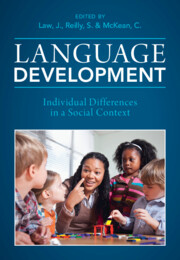Book contents
- Language Development
- Language Development
- Copyright page
- Contents
- Figures
- Tables
- Contributors
- A Tribute to Our Friend, Colleague and Fellow Editor, Professor James Law
- Introduction
- Part One Factors Influencing Language Development
- Part Two Continuity and Change
- Part Three Impact, Intervention and Equity
- 15 Communication, Participation and Cohort Studies
- 16 Capturing the Voice of Parents and Children
- 17 Oral Language Skills as a Foundation for Learning to Learn
- 18 The Economic Impact of Low Language Ability in Childhood
- 19 A Review of Interventions to Promote Language Development in Early Childhood
- 20 Interventions to Promote Language Development in Typical and Atypical Populations
- 21 The Effect of Kindergarten Instructional Policies on Reading and Math Achievement Gaps
- 22 Educational Interventions Targeting Language Development
- 23 Equity and Access to Services for Children with Language Difficulties
- Index
- References
17 - Oral Language Skills as a Foundation for Learning to Learn
from Part Three - Impact, Intervention and Equity
Published online by Cambridge University Press: 11 August 2022
- Language Development
- Language Development
- Copyright page
- Contents
- Figures
- Tables
- Contributors
- A Tribute to Our Friend, Colleague and Fellow Editor, Professor James Law
- Introduction
- Part One Factors Influencing Language Development
- Part Two Continuity and Change
- Part Three Impact, Intervention and Equity
- 15 Communication, Participation and Cohort Studies
- 16 Capturing the Voice of Parents and Children
- 17 Oral Language Skills as a Foundation for Learning to Learn
- 18 The Economic Impact of Low Language Ability in Childhood
- 19 A Review of Interventions to Promote Language Development in Early Childhood
- 20 Interventions to Promote Language Development in Typical and Atypical Populations
- 21 The Effect of Kindergarten Instructional Policies on Reading and Math Achievement Gaps
- 22 Educational Interventions Targeting Language Development
- 23 Equity and Access to Services for Children with Language Difficulties
- Index
- References
Summary
Language skills are fundamental to children’s achievement as they are both a predictor of future academic success and school engagement and the conduit by which learning takes place. Language difficulties have well-documented consequences on virtually all areas of children’s development. This chapter addresses how early language system weaknesses impact on the academic outcomes and quality of life of children and their capacity to participate in activities with their peers. Understanding the impact of language weakness on the emergence of literacy skills and academic abilities can inform universal and targeted interventions within education settings, in early childhood and the early years of school. These educational interventions are described and the evidence for their short-term, mid-term and long-term impact is reviewed. The chapter concludes with a discussion about what is required to harness the potential of educational settings to provide rich language learning experiences in classrooms which can reduce inequities, enable positive engagement in school and foster social-emotional well-being. If classrooms are to be harnessed in this way, schools and early childhood settings need to focus on the fundamentals of high-quality teaching practices to improve all children’s language and literacy outcomes.
Information
- Type
- Chapter
- Information
- Language DevelopmentIndividual Differences in a Social Context, pp. 397 - 419Publisher: Cambridge University PressPrint publication year: 2022
References
Accessibility standard: Unknown
Why this information is here
This section outlines the accessibility features of this content - including support for screen readers, full keyboard navigation and high-contrast display options. This may not be relevant for you.Accessibility Information
- 1
- Cited by
